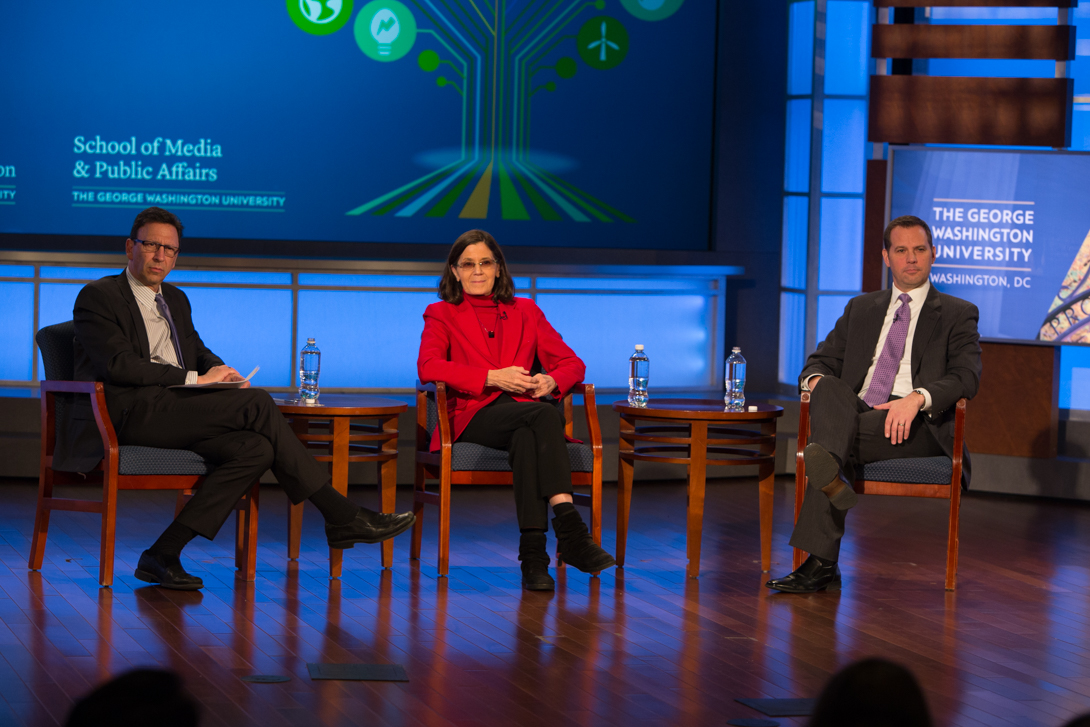By James Irwin
In order to find common ground regarding climate change and clean energy, U.S. leaders may need to shift the conversation away from science and toward economic reality.
“My sense is that we are driving toward a clean-energy, low-carbon future,” said Lynn Scarlett, global manager for public policy at the Nature Conservancy and former deputy secretary of the Department of Interior under President George W. Bush. “You are seeing a narrative coming from the private sector that this is about economic opportunity.”
Speaking at an event hosted by the Trachtenberg School of Public Policy and Public Administration and the School of Media and Public Affairs, Dr. Scarlett and Aspen Institute Senior Fellow Mike Boots outlined areas of common ground on a polarized topic among U.S. political leaders.
In December, representatives from 195 countries reached a landmark climate deal in Paris. On the campaign trail, nearly every Republican presidential hopeful either denies the existence of climate change or the role of people in contributing to it. Science and research in recent years have become politicized topics on Capitol Hill. Earlier this month, the Supreme Court blocked the enforcement of President Barack Obama’s Clean Power Plan, a cornerstone of the emissions reductions the U.S. agreed to in Paris.
But both Dr. Scarlett and Mr. Boots believe the United States is at a turning point in favor of clean-energy measures. They said the behaviors of cities, states and the private sector are key indicators.
“A thousand city mayors showed up [in Paris] and made commitments to drive toward a low-carbon city future,” Dr. Scarlett said. “You had hundreds of companies and, for the first time, investors from the financial sector. Twenty-nine U.S. states have renewable portfolio standards, and a lot of those are Republican states. You also see a lot of states with energy efficiency standards.”
Public demand for choice and energy efficiency creates an economic factor that cannot be ignored, Dr. Scarlett said. Infrastructure needs also play a role. The shift toward clean energy solutions comes at a time when the United States needs to overhaul an antiquated energy system.
“Our electric utilities are built on the vision Thomas Edison had 100 years ago,” Dr. Scarlett said. “It makes the consumer choice difficult. It makes distributed generation and rooftop solar difficult. People want choice, they want to be able to have energy efficiency. Industries and cities want energy reliability.”
States, cities and the private sector are both driving the new market and reacting to the reality of what that market creates, said Mr. Boots, the former head of President Obama's Council of Environmental Quality.
“You have Republican and Democratic mayors, county councils, chambers of commerce, CEOs and governors who have long since left behind the science question,” he said.
That, he added, will continue to be the case regardless of the outcome of Tuesday’s Supreme Court ruling, which is likely to return to the high court after going through the appellate process.
“I don’t think the question is whether you will have a system to regulate what comes out of power plants,” he said. “I think the question will be how you do it. I think some states have noticed that this is the way the market is moving and are investing in this direction because they know we’re heading this way.”
Those are drivers for both Democratic and Republican leaders—even on Capitol Hill. The budget passed in December included multi-year extensions of solar and wind tax credits. Those are major economic incentives in favor of clean energy, Mr. Boots said. At the local level, that also translates to jobs in manufacturing and construction.
“You look at how many jobs are coming from clean energy—new building materials, new innovations to make things cleaner, cheaper and smarter,” Dr. Scarlett said. “Republican governors and legislators are looking at it and saying they’ll support it because that’s our future.”


